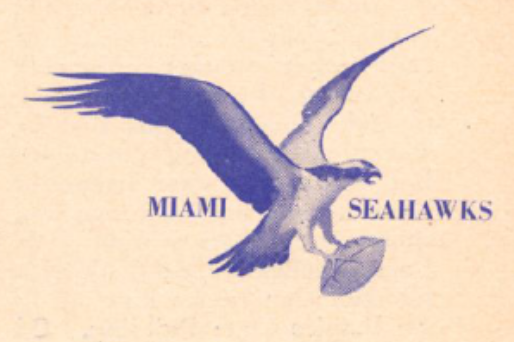A franchise history review of the All-America Football Conference Miami Seahawks football team. Their origin through the demise and things in between
Miami Seahawks
The Original Florida Pro Football Team
When we think about pro football in the state of Florida today we of course think of the NFL and the Miami Dolphins, the Tampa Bay Buccaneers or the Jacksonville Jaguars. Did you know that none of these NFL franchises were the first professional gridiron team in the state of Florida? Heck the NFL wasn't even the first pro league to place a franchise in the Sunshine State. The third rendition of the AFL brought us the current Miami Dolphins in 1966 but it was the AAFC some twenty years earlier that placed the first paid squad of players in Florida.
That team was the Miami Seahawks and it has no historic connections to either of today's franchises that they share a name with. No this Seahawks team's history started and ended in of all places Baltimore, Maryland.

The Baltimore loop
In the mid-1940s as Arch Ward was gathering together a group of potential owners for his newest football venture of the All-American Football Conference. We discussed this in our last episode that was focused on the start of the AAFC. One of the original franchises was supposed to be in the city of Baltimore as owner candidate George Tunney, the former boxing great, was organizing and heading a group of investors that wanted to have a pro football franchise centered there. They did the financial work to be able to have the franchise but when they could not secure a stadium deal Tunney had to ring the bell and get out of the ring, so to speak in this fight.
The ever-resourceful Arch Ward called upon a plan B option at the last hour, and a new group with the main owner of Harvey Hester was given the franchise as he had both the cash and the rights to play in Miami's Orange Bowl stadium. They would call themselves the Seahawks but they had more of an uphill climb that the other clubs in the AAFC. First off they were playing in a market that was less than half of the other clubs in the League. All other cities were at least in the top 15 of the USA's major metro areas at the time, but Miami was not even close at the time. This made for some trouble trying to gain fan support that would generate enough revenue and fill the large stadium of the Orange Bowl. Secondly, Hester was not as wealthy as the other owners. They had deep pockets to keep a franchise rolling in an inaugural season of a new league, but old Harvey, unfortunately, did not have the same size bank account. Cleveland's coach Paul Brown later summarized this fact by saying something to the effect that Harvey could not even comfortably play in the same poker game as the other AAFC owners.
Regardless of the obstacles, the Seahawks trudged on. They hired their first coach Jack Meagher a former Notre Dame college player and even had a stint in the early NFL with the Chicago Tigers as a platoon player before he moved into the coaching ranks at college programs such as Auburn where he was the head man from 1934 to 1942. He even took Auburn to its first-ever bowl game, The Bicardi Bowl in Cuba. The Seahawks had a tough start playing their first three games on the road, and they dropped all of them. Meagher after leading the Miami club through its first six games and garnering just one victory abruptly handed in his resignation. Hester almost immediately hired former Chicago Bears captain, Hamp Pool, to guide his franchise. Pool had the advantage of playing the last six games at home, a League strategy of using the warm Florida air near the season's end to keep fans going to games, or at least so they thought. The Seahawks lost those six in the homestand as well. However, the Seahawks did set some essential test marks that would be used later in pro football.
They played three straight Monday evening games in November and many say this was the basis for what brought about Monday Night Football some 24 years later. It didn't do much for the financial situation of the club though as they were some $350,000 in th hole at the season's end. A debt that Harvey Hester could not afford. A couple of group's tried to buy the franchise rights from Hester to keep the team in Miami, but none of them wanted to get stuck with Harvey's debt from the first season. Hester could wait no longer and filed for bankrupptcy. The Seahawks were in financial distress and thus the franchise was stripped from Hester and the AAFC sold it to a new investor group from Baltimore that had a stadium deal in hand as well as deep pockets. A Washington D.C. attorney, Robert D. Rodenburg and four other businessmen were awarded the club and reformed the team in Baltimore and renamed it, and the original incarnation of the Baltimore Colts was born. We will get to talk more about them in a couple days with historian Larry Schmitt and in even more detail in a few weeks when we spotlight the Colts AAFC teams.
The city of Miami would not enjoy pro football again with their own franchise until the 1966 AFL season when actor Danny Thomas partnered with Joe Robie to build the Dolphins organization. Stories have it that Ralph Wilson considered placing his AFL franchise there in the early 1960s but city officials rejected his offer. Stay tuned every Monday for the next two months as we will cover every AAFC team in detail.
Credits
The Miami Seahawks logo above was contributed by Larry Schmitt and was cropped from a September 14, 1946 NY Yankees versus Buffalo Bisons game day program.





